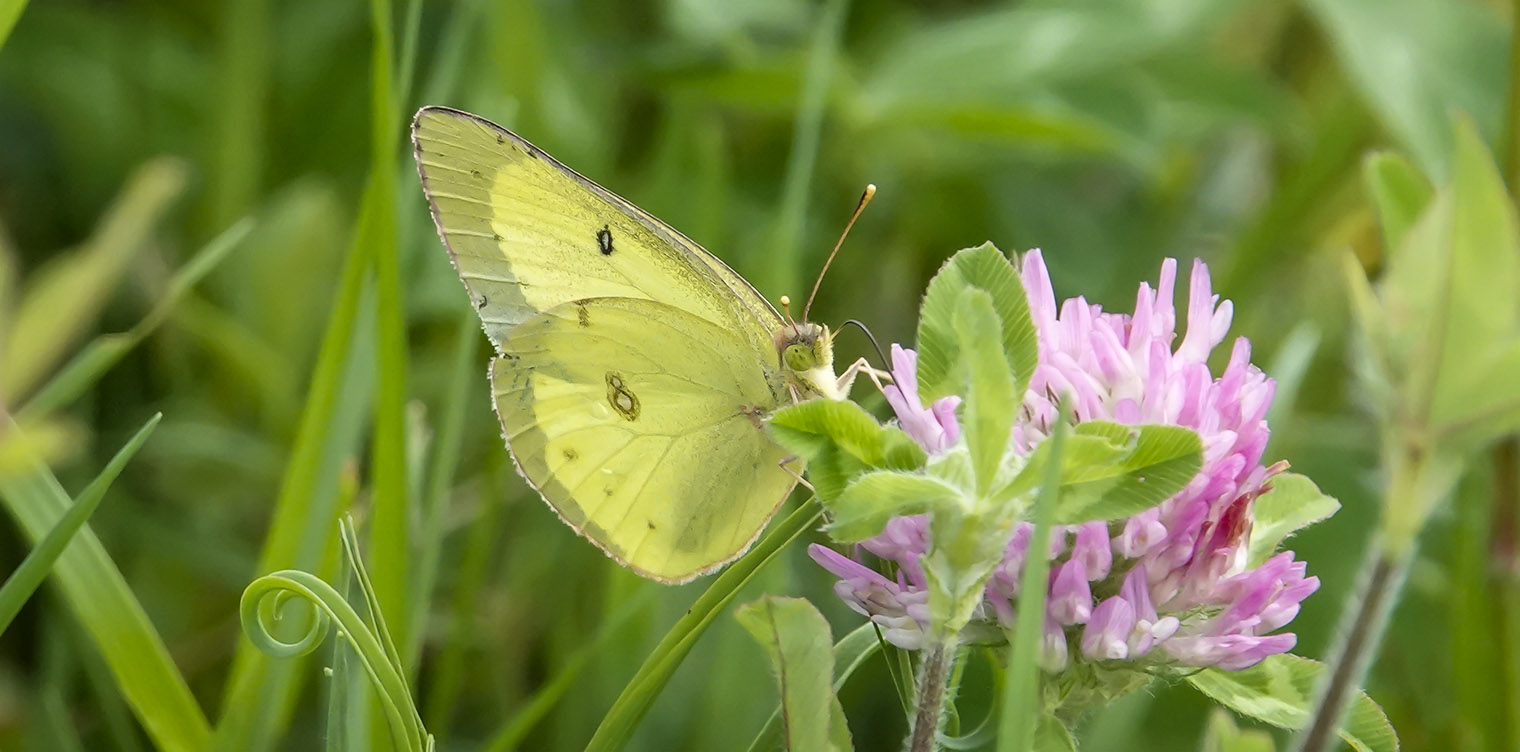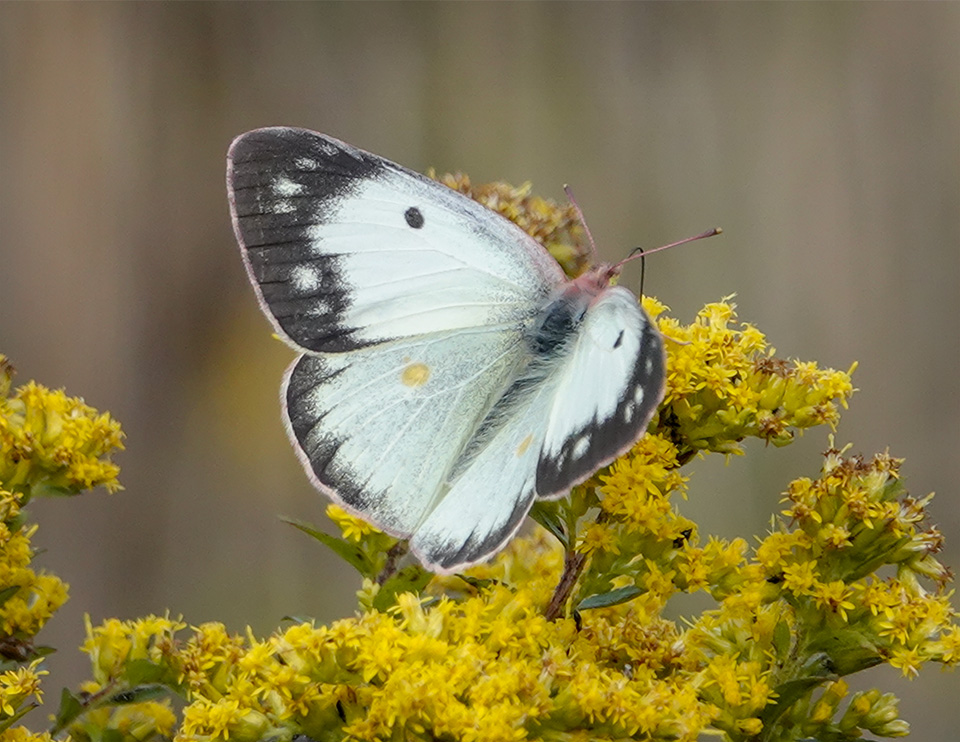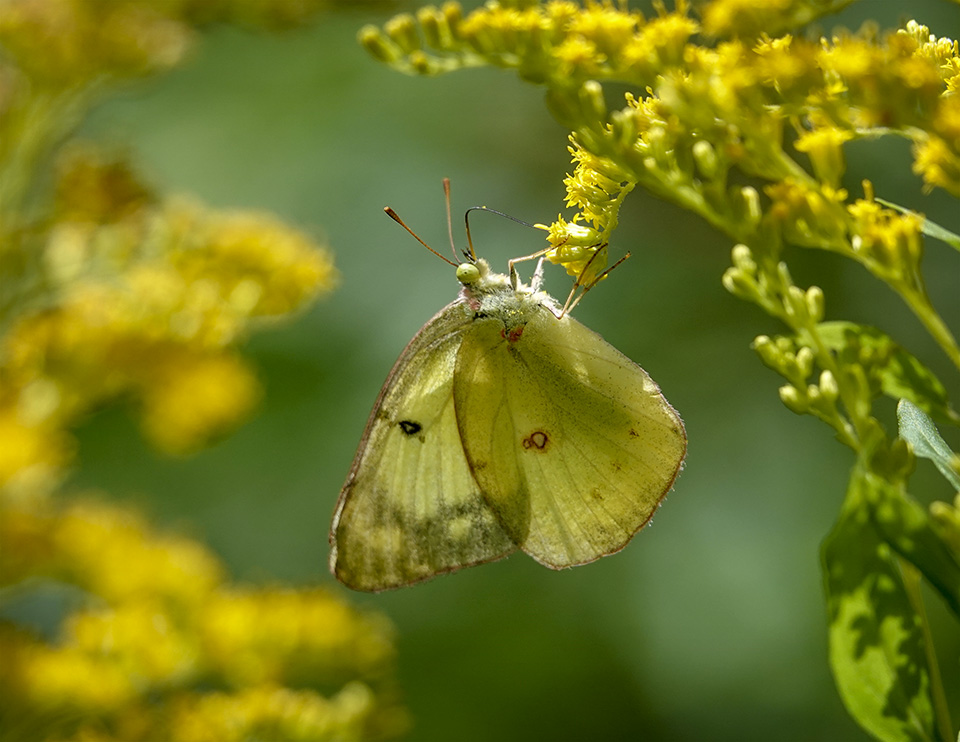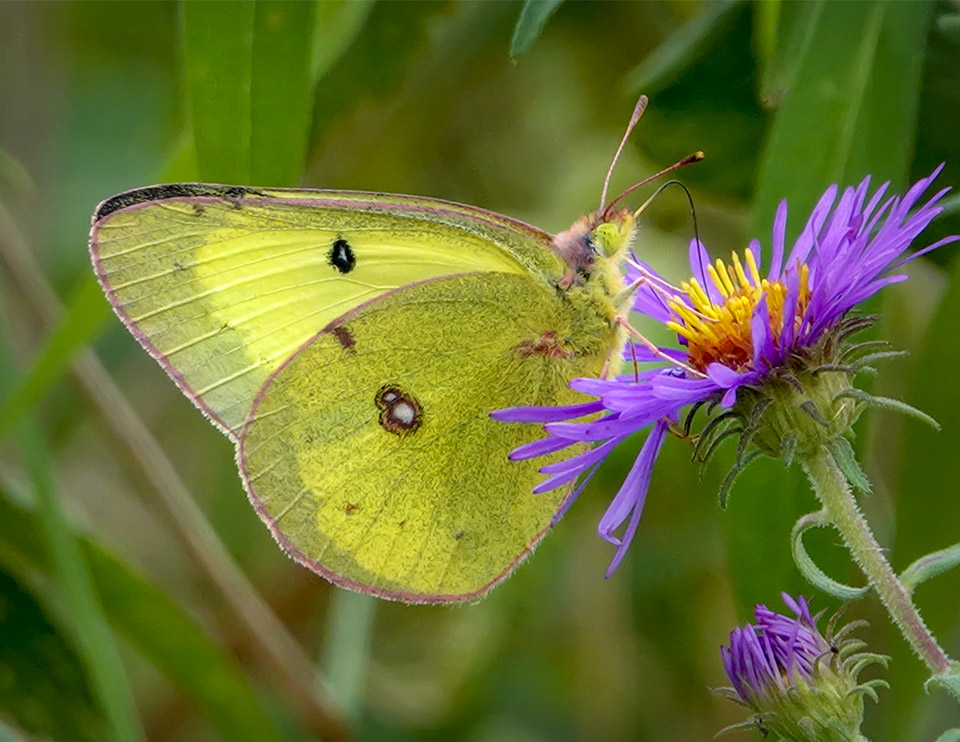Butterflies of the Adirondacks:
Clouded Sulphur (Colias philodice)

The Clouded Sulphur butterfly (Colias philodice) is a medium-sized yellow North American butterfly which may be seen in the Adirondack Mountains in upstate New York throughout summer. It is also called the Common Sulfur. [1]
The Clouded Sulphur is one of three members of the Colias genus found in the Adirondack Park. The others are the Orange Sulphur and the Pink-edged Sulphur. Butterflies in this genus are usually some shade of yellow, orange, or white. [2] Seen from above, they have black borders, solid in males, but with pale spots in females. All of our sulphurs usually perch with closed wings, which complicates identification.
Clouded Sulphur: Identification

Male Clouded Sulphurs have sharply defined black borders on all four wings on the upper side, while the female has yellow spots in the black border. Clouded Sulphurs usually land with their wings closed, so it is difficult to get a clear view of their upper surfaces. [3] [4]
The underside of the male's wings is yellow while the female's is yellow or greenish-white. The underside of the wings has a row of small brown submarginal spots. The under side of the hind wing usually has a silver cell spot rimmed by pink. [5]
Spring and fall forms of the Clouded Sulphur reportedly are smaller and less conspicuously marked. [6] Moreover, both sexes tend to be greenish yellow in the spring and fall, clear yellow in midsummer. [7] The female has a white form. [8]
This butterfly is difficult to distinguish from its close relative, the Orange Sulfur, [9] some of which show very little orange. [10] Yellow-orange hybrids with Orange Sulfurs reportedly occur.[11] [12]
Clouded Sulphur: Life History

The Clouded Sulphur lays eggs singly on top of the host plant leaf, hatching in about five days. The eggs are yellow when fresh, changing to crimson. [13]
The eggs hatch into smooth green larvae with a dark stripe down the back and light stripes on the sides. [14] Caterpillar hosts include plants in the pea family, such as alfalfa, vetches, and white clover. The chrysalis is green and pointed at both ends. [15]
Adults consume the flower nectar of many plants, including Joe Pye Weed and goldenrods. [16] This butterfly is an avid mud-puddler; and swarms of Clouded Sulphurs can often be seen fluttering around a mud puddle. [17] Sulfurs reportedly fly steadily with little gliding. [18]
Clouded Suphur: Habitat and Range
From the ecological standpoint, the Clouded Sulphur is a generalist. [19] Wide-ranging and adaptable, this butterfly can be found in many different open areas, including fields, lawns, road edges, marshes, bogs, and meadows. [20] The Clouded Sulphur is absent from dense forests. [21]
The Clouded Sulphur is said to be one of the most widespread and common North American butterflies. [22] Its range is Alaska south through central and southeast Canada and the US, [23] including Texas, Western Canada, Southeast, Southwest, Florida, Plains, Rocky Mountains, Eastern Canada, Northwest, New England, Great Lakes, Mid-Atlantic, Alaska, and California.
Clouded Sulphur: Flight

In the northern parts of its range, the Clouded Sulphur has two or more overlapping broods each year, with a flight period from May into late October. [24] In the New York City area, Clouded Sulphurs are reported to be most abundant in early to mid-July, [25] while in Canada this butterfly reaches its peak in numbers in the late summer and early fall. [26]
The flight period for Clouded Sulphurs in the Adirondack Park is not known. However, these butterflies may be seen in our part of the Adirondack Mountains throughout much of the summer.
- During the summer of 2012, we had Cloudeds in the Paul Smith's College VIC Native Species Butterfly House from 11 June to 18 August and another batch in late August-September in the adjacent Butterfly Garden. [27]
- Based on confirmed sighting from subsequent years, it appears that Clouded Sulphurs are present in the Adirondack Mountains in July, August, September, and early October. [28]
References
- Susan Grimm Hanley. Interpretive Naturalist, Paul Smith's College Native Species Butterfly House. Species Logbooks.
- Butterflies and Moths of North America. Species Profiles. Sighting records: 6/16/2012; 7/18/2013; 7/18/2013; 7/18/2013; 7/27/2013; 7/27/2013; 8/10/2013; 7/5/2014; 7/5/2014; 7/5/2014; 7/19/2014; 6/26/2015; 7/18/2015; 6/18/2018; 6/20/2018; 6/30/2018; 6/31/2018; 7/8/2018;7/11/2018; 7/12/2018; 7/13/2018; 7/13/2018; 7/15/2018; 7/15/2018; 7/15/2018; 7/15/2018; 7/18/2018; 7/18/2018; 7/20/2018; 8/4/2018; 8/9/2018; 8/11/2019; 8/19/2018; 8/31/2018; 8/31/2018; 9/4/2018; 9/7/2018; 9/7/2018; 9/7/2018; 9/13/2018; 9/13/2018; 9/13/2018; 9/14/2018; 9/14/2018; 9/19/2018; 9/23/2018; 9/23/2018; 10/10/2018; 10/10/2018; 6/8/2019; 7/21/2019. Retrieved 30 August 2019.
- iNaturalist. Clouded Yellows. Genus Colias. Retrieved 22 October 2021.
- Government of Canada. Canadian Biodiversity Information Facility. SpeciesBank. Retrieved 30 August 2019.
- Massachusetts Butterfly Club. Massachusetts Butterfly Species List. Retrieved 30 August 2019.
- Massachusetts Audubon. Butterfly Atlas Species Accounts. Retrieved 30 August 2019.
- Iowa State University. Department of Entomology. BugGuide. Retrieved 30 July 2019.
- National Audubon Society. Field Guide to Butterflies (New York: Alfred A. Knopf, 1981), pp. 371-372.
- Jim P. Brock and Kenn Kaufman. Kaufman Field Guide to Butterflies of North America (Houghton Mifflin, 2003), pp.60-61.
- Paul A. Opler. A Field Guide to Eastern Butterflies (The Peterson Field Guide Series, Houghton Mifflin Company, 1992,1998), pp. 60-61, 154-155.
- Jeffrey Glassberg. Butterflies of North America (MButterflies through Binocularsichael Friedman Publishing, 2002), pp. 76-77.
- James A. Scott. The Butterflies of North America. A Natural History and Field Guide (Stanford University Press, 1986), p. 198-199.
- Donald and Lillian Stokes. Stokes Butterfly Book. The Complete Guide to Butterfly Gardening, Identification, and Behavior (Little, Brown and Company, 1991), pp. 54-57.
- Jeffrey Glassberg. Butterflies through Binoculars. The East. A Field Guide to the Butterflies of Eastern North America (Oxford University Press, 1999), p. 56-57, Plate 8.
- Paul A. Opler and George O. Krizek. Butterflies East of the Great Plains: An Illustrated Natural History (The Johns Hopkins University Press, 1984), pp. 64-65.
- Rick Cech and Guy Tudor. Butterflies of the East Coast. An Observer's Guide (Princeton University Press, 2005), p. 84.
